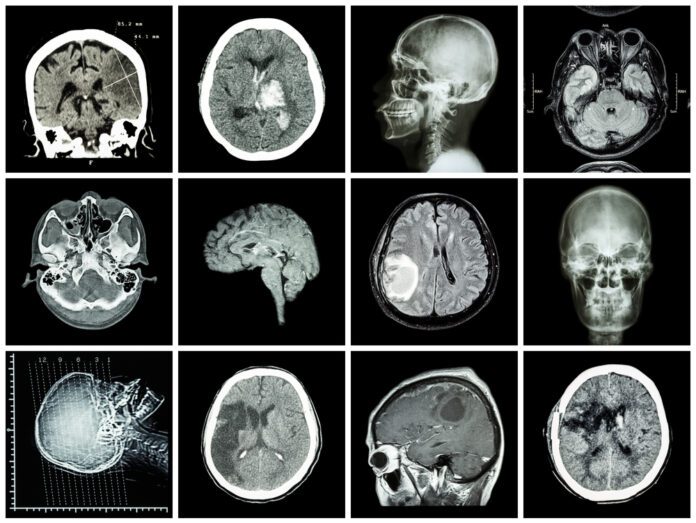Overview Of Primary Familial Brain Calcification
Primary Familial Brain Calcification is a condition characterized by abnormal deposits of calcium (calcification) in blood vessels within the brain. These calcium deposits are visible only on medical imaging and typically occur in the basal ganglia, which are structures deep within the brain that help start and control the movement of the body. Other brain regions may also be affected.
The main signs and symptoms of primary familial brain calcification are movement disorders and psychiatric or behavioral problems. These difficulties usually begin in mid-adulthood and worsen over time. Most affected individuals have a group of movement abnormalities called parkinsonism, which includes unusually slow movement (bradykinesia), muscle rigidity, and tremors. Other movement problems common in people with this condition include involuntary tensing of various muscles (dystonia), uncontrollable movements of the limbs (choreoathetosis), and an unsteady walking style (gait).
Psychiatric and behavioral problems occur in 20 to 30 percent of people with primary familial brain calcification. These problems can include difficulty concentrating, memory loss, changes in personality, a distorted view of reality (psychosis), and a decline in intellectual function (dementia). Affected individuals may also have difficulty swallowing (dysphagia), impaired speech, headache, episodes of extreme dizziness (vertigo), seizures, or urinary problems.
The severity of primary familial brain calcification varies among affected individuals; some people have no symptoms related to the condition, whereas others have significant movement and psychiatric problems.
Commonly Associated With
- bilateral striopallidodentate calcinosis
- cerebrovascular ferrocalcinosis
- familial idiopathic basal ganglia calcification
- FIBGC
- striopallidodentate calcinosis
Causes Of Primary Familial Brain Calcification
Primary familial brain calcification is caused by mutations in one of several genes. The most commonly mutated gene is called SLC20A2, and accounts for an estimated 40 percent of cases, followed by the PDGFRB gene, which is mutated in about 10 percent of cases. Changes in other genes each account for a small percentage of cases. In about half of individuals with primary familial brain calcification, the genetic cause is unknown. These individuals are thought to have mutations in genes that have not yet been linked to the condition.
The SLC20A2 gene provides instructions for making a protein called sodium-dependent phosphate transporter 2 (PiT-2). This protein is highly active in nerve cells (neurons) in the brain where it plays a major role in regulating phosphate levels (phosphate homeostasis) by transporting phosphate across cell membranes. SLC20A2 gene mutations lead to the production of a PiT-2 protein that cannot effectively transport phosphate into cells. As a result, phosphate levels in the bloodstream rise. In the brain, the excess phosphate combines with calcium and forms deposits within blood vessels in the brain.
The PDGFRB gene provides instructions for making a protein that transmits signals from the cell surface into the cell. These signals control a variety of cell processes. PDGFRB gene mutations result in a protein with impaired signaling ability. However, it is unclear how the mutations cause primary familial brain calcification. The altered signaling may result in an abnormally large amount of calcium entering the cells that line blood vessels in the brain, leading to calcification of these blood vessels. Alternatively, changes in PDGFRB signaling could disrupt processes that regulate levels of phosphate and calcium in brain cells, leading to the formation of calcium deposits. Other genes known to be associated with primary familial brain calcification also have roles in cell signaling and phosphate homeostasis.
Researchers suggest that calcium deposits lead to the features of this condition by disrupting the connections between the basal ganglia and other areas of the brain, particularly the frontal lobes. These areas at the front of the brain are involved in reasoning, planning, judgment, and problem-solving. The regions of the brain that regulate social behavior, mood, and motivation may also be affected.
Research has shown that people with significant calcification tend to have more signs and symptoms of primary familial brain calcification than people with little or no calcification. However, this association does not apply to all people with this condition.
Other
In most cases, primary familial brain calcification is inherited in an autosomal dominant pattern, which means one copy of the altered gene in each cell is sufficient to cause the disorder. In most cases, an affected person has one parent with the condition.
Less commonly, primary familial brain calcification is inherited in an autosomal recessive pattern, which means both copies of the gene in each cell have mutations. The parents of an individual with an autosomal recessive condition each carry one copy of the mutated gene, but they typically do not show signs and symptoms of the condition.



